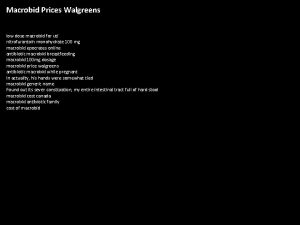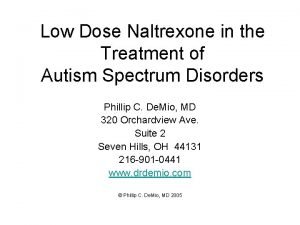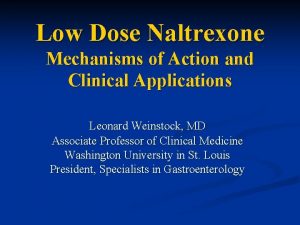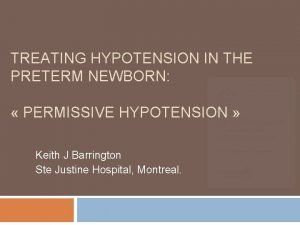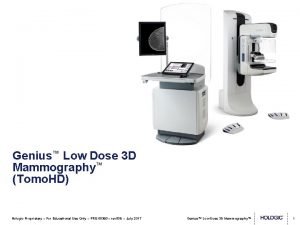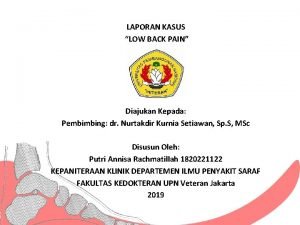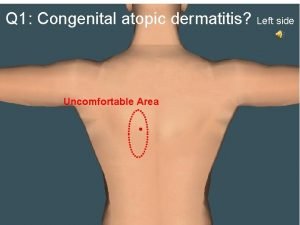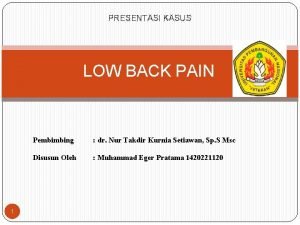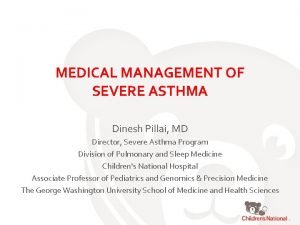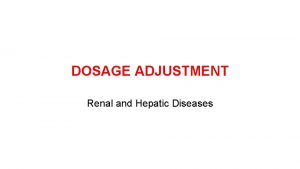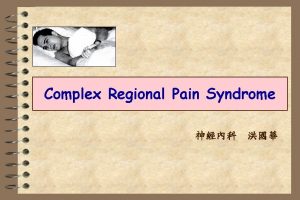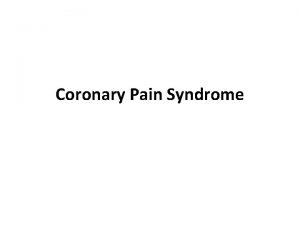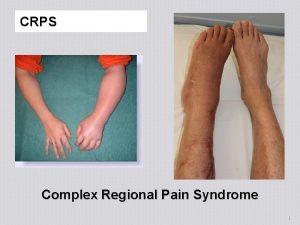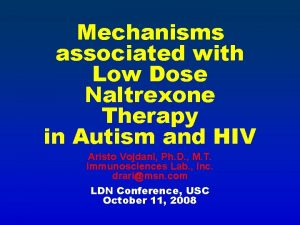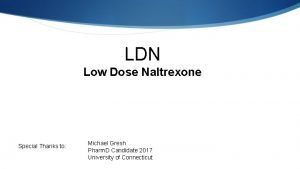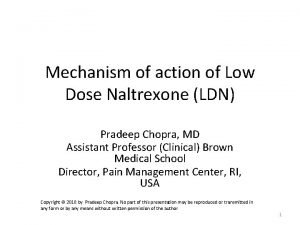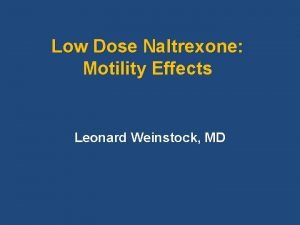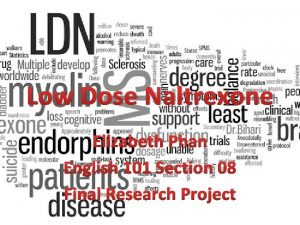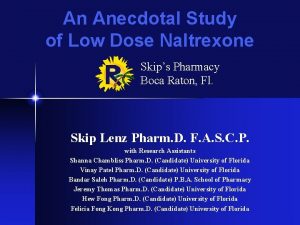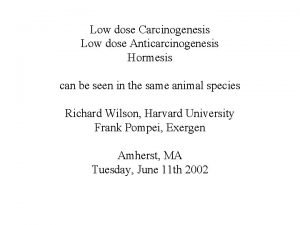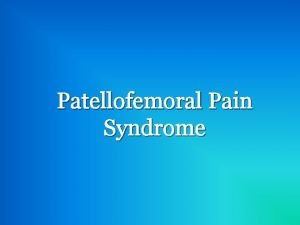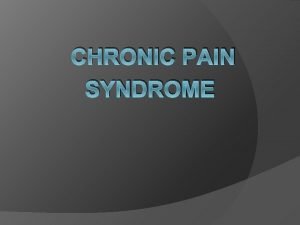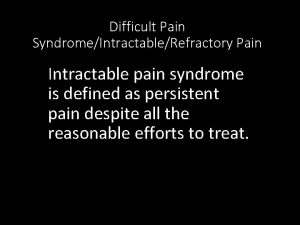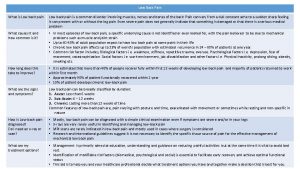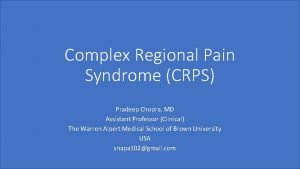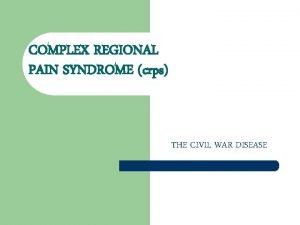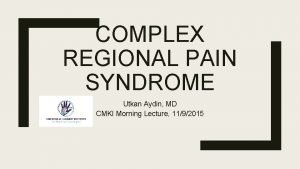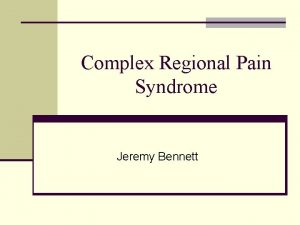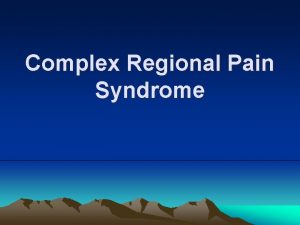Low Dose Naltrexone and Complex Regional Pain Syndrome






























- Slides: 30

Low Dose Naltrexone and Complex Regional Pain Syndrome Leonard Weinstock, MD Associate Professor of Clinical Medicine Washington University in St. Louis President, Specialists in Gastroenterology

Disclosures n Speakers Bureau: n n Salix, Entera Health, Forest Off label use of medication

Naltrexone n Anti-opioid n Approved by the FDA in 1985 to treat opiate dependence (Revia®, Depade® and extended-release Vivitrol® n Dose of 50 mg– 100 mg daily for opiate dependence

Off Label Use of Meds Legal and ethical in the confines of one’s own practice § Common for GI § § § Proton pump inhibitors Anti-depressants Prednisone, Immune-suppressants Antibiotics New for GI § Low dose naltrexone

2005 LDN § § § LDN part of Rx Prokinetic alternative Improve immunity

LDN: History § 1979 - 2015: Penn State endorphin research § 1985: Rx for AIDS (NYC) § Mid 90’s: Rx for MS (NYC) Zagon et al. Science 1983; 221: 671 -3. Bihari. AIDS Patient Care. 1995; 9: 3.

LDN: Rx Reports Anecdotal Published § § § § Cancer AIDS Fibromyalgia MS Complex regional pain syndrome IBS Crohn’s Disease Ulcerative colitis § § § § § CFS RA, AS, SLE Parkinson's disease Hailey-Hailey & Psoriasis Rosacea & Eczema RLS IC & CP Sarcoidosis Dercum’s disease 1100 SIG patients

Ulcerative Colitis: LDN Rx § Pt failing Remicade – high risk of colectomy § Now in remission 6 years – LDN added to biologic Rx Weinstock. J Clin Gastroenterol 2014; 48: 742.

Crohn’s Disease: LDN Rx § § § 40 y. o. WF s/p total colectomy; intestinal recurrence 4 yrs later; failing Remicade: diarrhea and fatigue LDN 4. 5 mg added; Endo & Clin remission in 2 mo Remission 5 years

CD and MS: LDN Rx § § § CRC screening of severe MS pt – ileitis without sx 2 weeks: MS clinical benefit 1 year: MS clinical benefit; ileal ulcers healed

Endogenous Opioids § B-endorphins, enkephalins, endomorphin, dynorphin § Opioid cells locations: § § § Entire nervous system Adrenal glands GI tract § § § Myenteric plexus Mucosal plexus Intestinal endocrine cells

Endorphins: Functions § § Regulate cell growth Decrease inflammation Decrease permeability Stabilize Toll-like receptors § § Decrease microglia activation Decrease cytokine release Shift from TH 2 to TH 1 Improve GI motility

Opioid Cell/Receptor Functions Endorphins Activated Cell § Regulates T- & B-cell production § Maintains blood vessel barriers

Narcotics, LPS, Thrombin “Breaking Bad” Continuous Over-activated Receptors Inflammation and Endothelial cell barrier disruption

How Does LDN Work? § LDN displaces endorphins from receptors for 4 hours § Cells sense opioid deficiency and rebound via a positive feedback mechanism Receptors increased § Met-enkephalin production x 12 -15 fold §

LDN effect Activated Receptors Endorphins & receptors lead to decreased T- and B-cell activity & less permeability

Ehlers-Danlos Syndrome Bone and joint conditions Additional syndromes n n Hypermobility Bone fracture Joint dislocation Soft tissue joint disease (Often seen by Pain Management Physicians) n n n n n Dermal changes Dental involvement GYN/OB disorders Vasomotor: postural orthostatic tachycardia/autonomic dysfx Vascular abnormalities Anxiety disorder Hernias Acid reflux Irritable bowel syndrome

Complex Regional Pain Syndrome § CRPS (AKA Reflex Sympathetic Dystrophy) § Spontaneous and/or evoked neuropathic regional pain with: § Vasomotor dysfunction § Motor/trophic dysfunction § Sudomotor/edema and sweating

Complex Regional Pain Syndrome § Incidence: § 5. 46 per 100, 000 person years (Mayo) § 26. 2 per 100, 000 person years (Netherlands) § Netherlands = 6 -fold larger study (600, 000 patients) § Female predominance: 4 to 1 (in each study) § Familial reports in Europe § Natural Hx: § Mayo - 75% spontaneous complete remission § Drexel University – 0/656 pts (dur. 1 - 46 y)

CRPS Triggers: Bone fractures (46%in Mayo study) n Sprains n Trauma (injections, nerve injury, surgery, burns, and frostbite) n Nerve injury n Infection n Stroke n Myocardial infarction n Pregnancy All associated with inflammation n

CRPS: GI disorders Dysbiosis – narrow microbiome spectrum n Increased intestinal permeability n Painful syndromes including irritable bowel syndrome are common in CRPS n n SIBO may be a factor in up to 50% of IBS pts and it can cause systemic inflammation and extra-intestinal disorders (fibromyalgia, restless legs

CRPS: Potential roles for LDN § Pathophysiology § Neurogenic inflammation – Reduce activity § Glial pain sensitization - Reduce activity § Vasomotor dysfunction - ? Endothelial permeability § Inflammatory triggers – Reduce cytokines and regulate T and B cell activity § Increased intestinal permeability – Repair gut immunity, permeability and motility reducing SIBO

CRPS: LDN Rx 2 cases with improvement Chopra. Neuroimmune Pharmacol 2013; 8: 470 -6

CRPS: SIBO and LDN Rx 53 y. o. WF 12 yr pain, 40 yr IBS, yrs poor sleep, & Sx for 45 yrs of Ehlers-Danlos § Abnl LBT and sleep study: § Xifaxan & LDN § CPAP § Relapse at 1 yr: § § Xifaxan CPAP Rx maximized Promotility Rx LDN continued § Remission 1 mo later

Remission & successful retreatment Weinstock et al. Pain Physician. Submitted

Ehlers-Danlos and CRPS Complex regional pain syndrome Ehlers-Danlos syndrome n Genetic disorder – n Familial - coincidence vs. prevalence 0. 2 – 2% common genetic risk n Bone fracture common n Central pain sensitization n GI symptoms common – autonomic dysfx and/or autonomic dysfx: risk for bacterial overgrowth n 5 reported cases of CRPS in n EDS in 25% of CRPS pts in EDS prior to 2013 one pain management practice from 2013 -2015

Are Ehlers-Danlos & CRPS Linked? Complex regional pain syndrome Ehlers-Danlos syndrome n Connective tissue laxity n Sleep disturbances are very leads to obstructive sleep common apnea n OSA leads to hypoxia driven n Possible ongoing trigger to inflammation CRPS n n Gastrointestinal symptoms common – autonomic dysfx and/or bacterial overgrowth Bacterial overgrowth leads to inflammation n n Gastrointestinal symptoms common – autonomic dysfx: risk for bacterial overgrowth Possible ongoing trigger to

Are Ehlers-Danlos & CRPS Linked? Internet poll of RDS support group adult members Irritable bowel syndrome n Present in 99/177 (56%) n Vs. 3%-20% in USA Sleep apnea n Present in 59/177 (33%) n Vs. 3%-28% in USA

Future CRPS Study Irritable bowel syndrome n n n Prevalence of positive LBT Effect of treating SIBO Sleep apnea n n n Prevalence sleep disturbance Prevalence of positive sleep study Effect of treating OSA Ehlers-Danlos syndrome n Prevalence n Correlation with IBS and OSA n Effect of treating with low dose naltrexone

Individual Syndromes Overlapping Linked to SIBO P-physiology Genetic Risk Idiopathic syndromes IBS Pi-IBS RLS Inflamm Rosacea SIBO FMS Dysbiosis CPPS Others Immune
 Macrobid epocrates
Macrobid epocrates Naltrexone and autism
Naltrexone and autism Naltrexone moa
Naltrexone moa Naltrexone black box warning
Naltrexone black box warning Martian pain
Martian pain Sore boobs early pregnancy
Sore boobs early pregnancy Dobutamine low dose
Dobutamine low dose Tomo hd
Tomo hd Symptoms before period
Symptoms before period Emotive communication style
Emotive communication style Discogenic low back pain
Discogenic low back pain Twisting vibration
Twisting vibration Laporan kasus ischialgia
Laporan kasus ischialgia Left side low abdominal pain
Left side low abdominal pain Laporan kasus low back pain
Laporan kasus low back pain What is a low spin complex
What is a low spin complex Mid = (low + high) / 2
Mid = (low + high) / 2 Significant figures
Significant figures Low voltage = low hazard
Low voltage = low hazard Simple compound complex and compound-complex sentences quiz
Simple compound complex and compound-complex sentences quiz Droplet infection
Droplet infection Compound complex simple sentences quiz
Compound complex simple sentences quiz Freud complexes
Freud complexes Psychodynamic and psychoanalytic theory difference
Psychodynamic and psychoanalytic theory difference Rorschach test answers
Rorschach test answers Low-effort syndrome
Low-effort syndrome Medium dose ics and laba
Medium dose ics and laba Radiation dose limits for workers and public pdf
Radiation dose limits for workers and public pdf Benzodiazepine dose and route
Benzodiazepine dose and route Benzodiazepine dose and route
Benzodiazepine dose and route Loading dose formula
Loading dose formula
